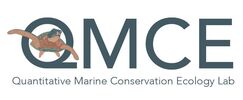Investigators: Susan Piacenza, Tabitha Siegfried, Chris Noren, Emma Roberto, Jackson Reimer, Lauren Bednaroski
Sea turtles are difficult to observe underwater and have very low encounter rates. As such, sea turtle biologists often rely on nesting beach surveys as an index of abundance and to estimate population trends. This approach leaves out many demographic groups, including juveniles. If biologists were able to reliably and consistently measure juvenile sea turtles, then we would improve the accuracy of assessments of population status and trends. With length-based indices, biologists could use a variety of length-based statistical methods to estimate changes in population size and predict changes to the adult populations, just as fisheries scientists do for fish stocks. A recent National Research Council review of sea turtle assessment procedures recommended that researchers should give high priority to generating estimates of survival of immature sea turtles, among other key demographic rates. Stereo-video cameras are one technology that may be a useful tool in this effort. Stereo-video length measurements are more accurate than visual estimates and do not require researchers to handle wild animals, which lowers potential behavioral biases and health impacts to the animal. We are running a field sampling program using stereo-video cameras to film sea turtles in key field sites in the northern Gulf of Mexico. Using specialized video analysis software, we digitally measure of animal morphometrics. This research has expanded to collecting data on various morphometrics to create statistical models to predict animal body weight, and to create a length-weight relationship for Green, Loggerhead and Kemp's ridley sea turtles. In the long-term, we will use this data to conduct length-based assessment models and mark-recapture analysis to estimate survival rates, size-at-maturity and to estimate abundance. Ultimately, this research effort will improve how sea turtles are monitored and assessed. This approach may also be adapted to other marine wildlife and used to improve how those species are monitored and conservation status is assessed as well.
Sea turtles are difficult to observe underwater and have very low encounter rates. As such, sea turtle biologists often rely on nesting beach surveys as an index of abundance and to estimate population trends. This approach leaves out many demographic groups, including juveniles. If biologists were able to reliably and consistently measure juvenile sea turtles, then we would improve the accuracy of assessments of population status and trends. With length-based indices, biologists could use a variety of length-based statistical methods to estimate changes in population size and predict changes to the adult populations, just as fisheries scientists do for fish stocks. A recent National Research Council review of sea turtle assessment procedures recommended that researchers should give high priority to generating estimates of survival of immature sea turtles, among other key demographic rates. Stereo-video cameras are one technology that may be a useful tool in this effort. Stereo-video length measurements are more accurate than visual estimates and do not require researchers to handle wild animals, which lowers potential behavioral biases and health impacts to the animal. We are running a field sampling program using stereo-video cameras to film sea turtles in key field sites in the northern Gulf of Mexico. Using specialized video analysis software, we digitally measure of animal morphometrics. This research has expanded to collecting data on various morphometrics to create statistical models to predict animal body weight, and to create a length-weight relationship for Green, Loggerhead and Kemp's ridley sea turtles. In the long-term, we will use this data to conduct length-based assessment models and mark-recapture analysis to estimate survival rates, size-at-maturity and to estimate abundance. Ultimately, this research effort will improve how sea turtles are monitored and assessed. This approach may also be adapted to other marine wildlife and used to improve how those species are monitored and conservation status is assessed as well.
All sea turtle species in US waters are on the US Endangered Species List. Since the in-water research conducted by the Piacenza QMCE Lab on endangered species is remote and encounters with animals are less than 5 minutes, we do not require scientific research permits from federal or state agencies. We have consulted with the relevant state and federal agencies to ascertain if scientific research permits are required. If you encounter sea turtles or other endangered marine species in the wild, do not approach them or follow them, as this could result in unintentional harm. Please see the NOAA webpage Marine Wildlife Viewing Guidelines for best practices.
